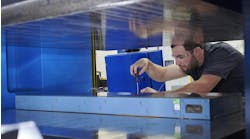We just received our copy of the NFPA Reporter, the monthly newsletter the organization sends out with its latest news and updates. This edition focused heavily on education support, with several items highlighting moves and developments the National Fluid Power Association, Center for Compact & Efficient Fluid Power (CCEFP), and NFPA Education and Technology Foundation are announcing to strengthen fluid power training.
The first is simply a save the date for a new Fluid Power Workforce which is designed to connect students and industry. The event will be hosted by NFPA and CCEFP on September 25-27, at the University of Illinois in Urbana-Champaign. Anyone from the fluid power community can attend. Poster sessions, discussion panels, "speed" meetings and facility tours are part of the plan. Further details will be announced as plans develop.
Along these same lines, the NFPA has developed a task force to update the “Your Career in Fluid Power” part of its web site. The project includes reorganizing the current information into two sections—Fluid power jobs and Fluid power education. One section will help people who are looking for jobs, and the other one will help people who are looking for information on what kind of education they will need to get a job. Plans to expand the site's “Job Descriptions,” “Salary Information,” “Finding a Career in Fluid Power,” and “Interactive Fluid Power Articles,” are in the works.
On to more hands-on news, the NFPA Education and Technology Foundation has initiated its Fluid Power Laboratory Program to establish a new, state-of-the-art training lab at a qualifying educational institution. Grant proposals are currently being reviewed and an award winner will be announced in May. Work on the lab should be completed during the fall semester. The second phase of the project will help match schools that already have labs with member companies that have offered to donate parts and equipment. The Foundation is just 10% away from reaching its funding goal, with support from Alro Steel, Bimba Mfg., Caterpillar, Deltrol Fluid Products, Dura-Bar, Eaton Corp., Enfield Technologies, HUSCO International, Motion Industries, Parker Hannifin, Poclain Hydraulics, ROSS Controls, Sauer-Danfoss, Sun Hydraulics and Wojanis Supply Co.
Contact Carrie Tatman Schwartz at [email protected] or (414) 778-3347 about either of those programs.
And finally, the Foundation has awarded a major research grant to the Agricultural and Biosystems Engineering Department at Iowa State University, for its project, Dielectric Spectroscope Sensor Development for Hydraulic Fluid Containment Detection, which will focus on developing new technology for low-cost, on-board, real-time fluid power sensors. The grant was submitted to the Foundation by associate professors Dr. Brian Steward and Dr. Stuart Birrell, in the Department of Agricultural and Biosystems Engineering at Iowa State University. The goal of this project is to develop a practical low-cost contaminant sensor for hydraulic fluids based on the results of a previously funded project by NFPA. This sensor will measure fluid dielectric properties at multiple frequencies based on previous work to detect water, iron, and dust contaminants using a simultaneous multi-frequency dielectric measurement technology similar to that developed by the research team in previous work.
Visit www.nfpa.com for more details on these and other news.
